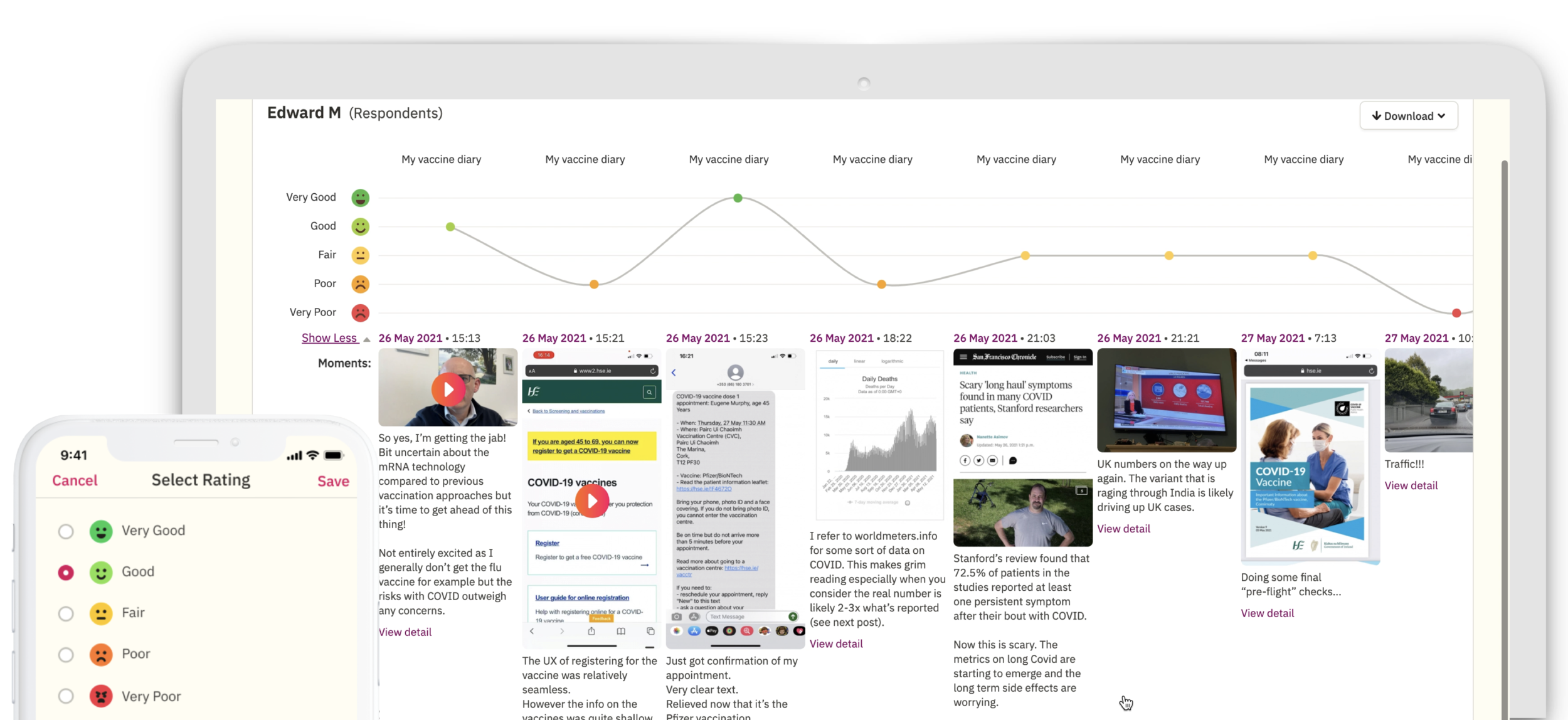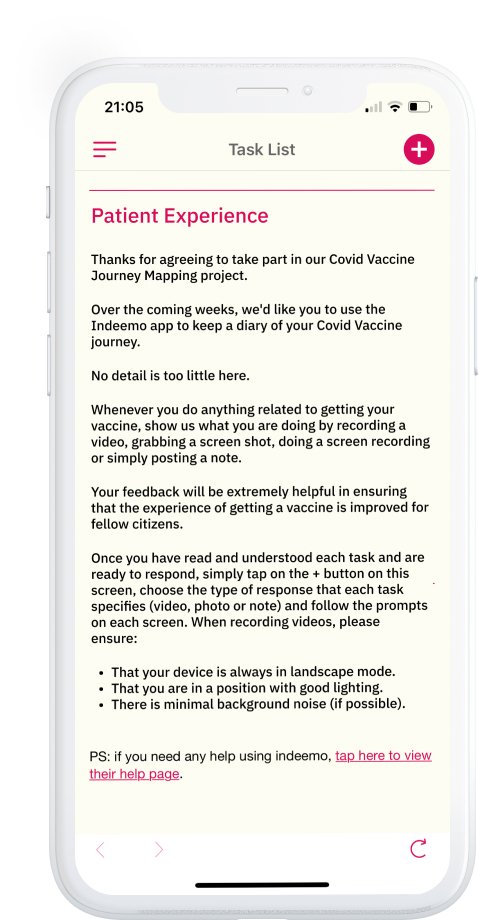Tips on how to use Patient Experience Research Tools as an Alternative to Patient Satisfaction Surveys
There is no one formula to conducting patient experience research. Traditional approaches often involve the use of quantitative techniques and tools. For instance, patient satisfaction surveys are commonly used as self-reported patient assessments that aim to measure appointment booking experiences, waiting times, and overall satisfaction with visits to a clinic/healthcare facility, to name a few.
Indeemo Customer Experience Research Tool
With the growing digitisation of healthcare (e.g. Digital Health and Tele-Health), patient experience and patient experience management has become, in many ways, complex. Just like in other sectors, such as retail where the path to purchase is increasingly becoming non-linear - The same can be said for healthcare. This has resulted in a parallel shift in how we conduct patient experience research, and what techniques and tools can provide the most informative insights into an increasingly digitised and non-linear sector.
Through the lens of qualitative methodologies, we are going to focus on the adoption and effectiveness of patient experience research tools. Although such tools can be used as a robust alternative to patient satisfaction surveys, both can be used in-tandem, where the insights from one (patient experience research tool - Qualitative) can directly inform the design and distribution of the other (patient satisfaction survey - Quantitative).
What is a Patient Experience Research Tool?
Before we identify a number of tips on how to use a patient experience research tool, this is probably the best time to explain exactly what the tool is.
A patient experience research tool is a piece of technology that is powered through mobile and smartphone devices, in the hands of research participants - and connects directly to a central repository in the form of a researcher dashboard. Although the technology itself has two central components - mobile app for research participants and dashboard for researcher - it is also a direct link between both personas that can improve the effectiveness of communication during patient experience research fieldwork.
Characteristics of a Patient Experience Research Tool
Leverages Qualitative Data & Multimedia
As an alternative to patient satisfaction surveys, this innovative technology has a number of differing characteristics. One of the core characteristics of a patient experience research tool is that it uncovers insights for researchers leveraged by qualitative data. This data comes in multiple forms. Video, photo, text, and mobile screen recording data are gathered through research participants self-reporting during fieldwork.
Indeemo Patient Experience Research Tool
Operates in Real Time Self-Reporting
A central component of a patient experience tool is to bring researchers closer to the lives of research participants. This is done through real time, or in the moment self-reporting. When research participants receive notification of their task or upcoming fieldwork tasks, they begin to record their experiences. Self-reporting often occurs in real time, and through the researcher dashboard, insights are uploaded and gathered automatically. This allows researchers to see, hear, and empathise with patients during the fieldwork process - essentially, providing in the moment insights into the patient experience.
Facilitates a range of Qualitative Research Methodologies
At the beginning of this article we mentioned that there is no one formula when setting out to conduct patient experience research. This means that a range of qualitative methodologies and research designs can be adopted and integrated into the patient experience tool.
Digital Ethnography
Ethnographic research and increasingly, Digital Ethnography, is one of the most popular methodologies that is used for patient experience research. Digital Ethnography has emerged as one of the leading qualitative methodologies to leverage remote research and mobile technology. Remote observations of research participants can be operationalised through the use of the patient experience research tool, where researchers can retrieve qualitative data and optimise insights for future in-depth interviews and/or focus group talking points.
Diary Study
Diary studies are one of the most popular qualitative research methods for uncovering rich insights into patient experience. Patient Diaries continue to inform healthcare providers with context surrounding patient experiences in and outside of the healthcare setting. Increasingly, diary studies are leveraging the power of technology, just like the patient experience research tool. Primarily because the data is not restricted to text format, but now video, photo, and mobile screen recordings increase the level of insight into patient experience.
Photovoice Method
Photovoice, although a well-established qualitative research methodologies, is often overlooked or underutilised in the context of patient experience. The concept is simple. This methodology leverages the power of photographs as a visual stimuli for research participants to reflect and provide insights on their feelings and opinions directed by the subject of photographs. Research participants usually take their own photographs. The patient experience research tool equally leverages the power of visual data and facilitates the photovoice method, where insights often inform participatory discussions on various components of the patient journey.
Taking all of this into consideration, back to the matter at hand. How can we use this tool for patient experience research? Not every patient experience research project will be the same. We may want to focus on one area of the patient journey. Our objective might centre around post treatment experiences. However, there are a number of tips that can be useful when adopting a patient experience research tool.
Tips for Adopting a Patient Experience Research Tool
1. Test Research Design for Optimal Integration
Although this might go without saying, at the initial stages of your project, research design is critical. Since the technology leverages on the principles of qualitative research, it is important to identify an objective that will afford the flexibility of exploration into the patient experience. The tool itself will support a range of methodologies, and with this in mind, our research design should be done so with integration into the technology in mind. Tip: Ensure you have reviewed and tested your research design and protocol when integrating with the tool.
2. Allow Time for Onboarding
Integrating any tool for your patient experience research requires sufficient time for your team of researchers, moderators, and project owners to be successfully onboarded. Those new to the technology will need time to be trained up. Additionally, you will need to factor in time for onboarding your research participants. Whilst research participants will be familiar with the ubiquitous features of the mobile app component of the tool, they will require dedicated time to ensure they understand what is asked of them, and what features they need to use during fieldwork.
3. Identify the Right Data Types
As patient experience research is not bound to traditional methodological approaches, the variety of data types we require has increased. We have seen this in the use of the methods outlined above. Moreover, a patient experience research tool encourages research and insights teams to be creative. Add value to your research objective by requiring insights of various data types. For instance, if we wanted to understand in-home care routines of patients post treatment, we can leverage video and integrate a task where research participants record their routines of post-care treatment.
4. Communicate with Research Participants during Fieldwork
A patient experience research tool works perfectly for remote qualitative research. This has become increasingly popular since the global pandemic. There are two primary benefits to having open communication with your research participants. First, due to the nature of remote research, it is important to check in with participants to ensure that they are engaging with the fieldwork tasks, and to ensure they understand the requirements of these tasks. Second, and more importantly, through the use of a patient experience research tool, researchers have the capability to dig deeper into the responses and uploads from participants. This is also an added benefit of real-time data capture. As participants submit responses to tasks (via video, photo, or text) in the moment, we get the data instantly. As we begin to uncover insights, there is also the possibility that the data prompts us to nudge our research participants. By having this open communication with them through the tool, we are able to ask follow up questions to their reported experiences. This gives an additional layer of insights.
Summary
How we capture insights about patient experiences has come a long way. Researchers, insights teams, designers, and patient experience management have begun to embrace new tools and technology to get under the hood of quantitative data and enrich experience research.
As an alternative to traditional ways of conducting patient experience research, such as satisfaction surveys - a patient experience research tool harnesses the power of mobile technology and embraces the characteristics of qualitative research.
We see qualitative insights becoming more prevalent with the use of innovative technologies for patient experience. As more healthcare professionals and researchers embrace qualitative insights coming directly from patients themselves, results can be leveraged to further enhance quantitative techniques and strategies, for the ultimate goal of improving patient experience and patient-centred care.
Contact us
We’ve supported thousands of research projects covering everything from mapping the path to purchase for aquarium filters to mortgage buyer journeys to mapping the patient journey of kidney transplant patients.
If you’d like to discuss a specific patient diary research project or are just curious to learn more, get in touch now.








